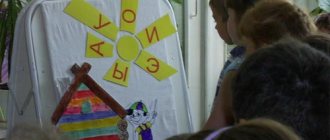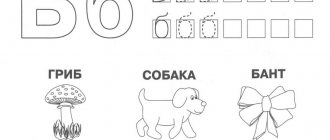Preparation for teaching literacy to children of senior preschool age
Key principles for preparing for literacy
Before moving to secondary school, literacy learning is usually structured as follows: Preparing to learn to read and write (Preschool education) → Ready to learn reading and writing (Preschool education) → Learning to read and write (Primary education) → Developing reading and writing skills letters (Primary education). The basis for successfully developing readiness to become familiar with literacy is the study of sound analysis and the development of graphic skills.
What needs to be taught to a child in preparation for mastering reading and writing:
- Identify sounds that occur frequently in words.
- Name words according to a specific phonemic feature.
- Carry out a sound analysis of words of 3-5 sounds during the modeling process.
- Correlate the spoken word with the diagram of its sound composition.
- In accordance with the game rules, change the sound composition of a word, name words with a certain sound, words of a given sound structure.
- Select words that are similar and opposite in meaning.
- When describing objects, use words that characterize their properties and qualities.
- Compose short stories on topics close to children.
- Compose a story based on a series of plot pictures.
- Participate in a group conversation and ask questions.
You will learn about the features of teaching reading and writing to preschoolers in our materials:
“Let them teach reading at school!”
“Developing preschool children: preparing the hand for writing. Where to begin?"
Features of the educational complex “Paths” and “Pre-school time”
The Russian Textbook Corporation presents the courses “Paths” (for systemic preschool education) and “Pre-school time” (for short-term groups and for preparing children at schools). The projects have already earned high praise from teachers. The publications present a methodology for preparing for learning to read and write, developed by a well-known specialist in the field of preschool and primary education, Lidia Zhurova, based on the popular method of Daniil Elkonin. The method involves preparation through five stages:
The first stage (and the most important). Skill training:
- intonationally highlight the sound in a word;
- name words with a given sound;
- highlight and name the first sound in a word;
- distinguish between hard and soft paired consonants (without introducing terminology).
Second phase. Teaching children the action of the sound composition of a word. During the sound analysis of words, the sound composition of the word is modeled using chips.
Third stage. Introducing letters that represent vowel sounds.
Fourth stage. Acquaintance with letters denoting consonants and mastering the reading mechanism.
Fifth stage. Working out the reading mechanism using material from the entire alphabet.
Let's take a closer look at how to build a sound analysis.
Let's learn to speak correctly. 3-4 years. Child benefit
The manual presents tasks on speech development aimed at clarifying the content of classes with children in the 2nd junior group of a preschool educational organization. The manual complies with the Federal State Educational Standard for Preschool Education (2014). The texts in the manual are intended to be read to children by adults.
Buy
Sound Analysis Action Operations
- Pronouncing a word while simultaneously moving the pointer along the sound pattern (the pronunciation and hand movement are being coordinated).
- Pronouncing a word with intonation highlighting the first sound.
- Pronunciation of the first sound is isolated, as it is heard in the word.
- Designation of sound with a chip (the chip is placed in the first cell).
- Continuation of work with subsequent sounds of the word in the indicated logic: the child points the pointer according to the diagram, pronounces the entire word, holds the pointer in the second cell, intonationally highlights the second sound, names the second sound in isolation and fixes it with a chip, then also highlights the third sound.
- After marking the last sound with a chip, it is mandatory to read the entire word.
The first stage - familiarization with sounds - is very important.
If a new student appears in a group several months before the end of preschool education, then the teacher must make a choice: immediately teach such a child to read or start preparing him? The right decision would be to choose preparation, since knowledge of phonemes will be useful to the child at school. #ADVERTISING_INSERT#
Including children in significant activities
The child’s sign activity, in fact, begins with a gesture, an indication of the desired object or a call to action. According to Vygotsky, gesture gives rise to speech, drawing and play - symbolic activities of the first order, which directly reflect reality. It is during the process of play that the object and its function are separated: different toys receive different purposes (an airplane - to fly, a car - to drive). With the help of names, the child establishes connections between a sign (name) and a specific object: he says “car” and picks up a car, not a plane. Speech, play and drawing give rise to written speech, symbolic activity of the second order (it no longer reflects immediate reality, but drawing or play). All these external symbolic forms of activity are included in the system of higher mental functions, which are formed in the process of social communication.
Therefore, a prerequisite for mastering sign-symbolic reality is the child’s interaction with adults and peers: the pointing gesture - the beginning of all principles - arises precisely from addressing another. If there is no one to show it to, then there is no point in it. The same goes for more complex activities: reading is always addressed to an imaginary interlocutor, writing is always addressed to an imaginary addressee. Only in this way do they arise as cultural functions. Otherwise, at the beginning of mastering literacy, the child does not understand why he himself needs it.
Thus, from an early age, mastering sign activities, the child feels quite comfortable, being under the guidance of an adult and surrounded by peers. The question remains: when is it appropriate to move from mastering one sign system to another, for example, from phonetics to grammar? Representatives of the Russian school of psychology have interesting answers to this question.
A little theory: sign and sign systems
Literacy is one of the sign (semiotic) systems that provide a uniform representation and interpretation of the signals and messages that people exchange in the process of transmitting information.
The formation and use of semiotic systems is a natural way for humans to structure experience, socialize and transfer knowledge from generation to generation. In fact, our entire existence is permeated with sign systems: phonetics, language, counting, ritual, art, etc. Social relations as a whole can also be considered as a sign system.
The unit and basis of any semiotic system is a sign - an abstract or material object, in relation to which it is accepted that it indicates a certain meaning. A sign has a plane of content—meaning—and a plane of expression—these are linguistic or material means by which the meaning is conveyed.
In cultural studies, the dual essence of the sign is well explained by the concept “Bonfire of Hell”. It is based on the Greek legend of how the young man Leander swam across the Bosphorus every night to meet his beloved. The sign of invitation to the beginning of his journey was the fire that the girl lit in her tower. Here the fire is the material expression of the sign. An invitation to a meeting – its meaning, content.
We can distinguish signs of personal use (for example, the fire from the above-mentioned legend) - they are understandable only to a few people, significant only in the context of their relationships - and signs of general and professional use (counting, language, ritual), with the help of which objects of nature and technology are included in culture. But in both cases, the creation of signs is a social activity that expresses the uniqueness of life, feelings, and mental activity of other people.
With the help of signs, we not only socialize, but also cognize reality: by constructing semiotic systems, we endow material and abstract objects with conventional meaning and establish connections between them. When these systems acquire a historical and social dimension (everyone distinguishes and interprets signs in the same way), they consolidate experience and serve to transmit it from generation to generation.
The transfer and assimilation of experience is facilitated by an important property of semiotic systems: the design of signs explains their content even if there is no special condition for understanding the meaning of an individual sign. A striking example of this is the phrase coined by Academician Shcherba: “The glokaya kuzdra shteko budlanula bokra and kurdyat bokrenok.” Despite the fact that we do not know the meaning of the words in this sentence, based on morphological features and their relationship to each other (which are given by the grammar system), we can understand the general meaning of the entire phrase: some feminine entity did something to another male entity , and then began (and still continues) to do something different with a smaller representative of the same species. This principle, for example, is indispensable in deciphering ancient writing.
It turns out that by understanding what a sign is, how it relates to reality (the plane of expression and the plane of content), and how at least one sign system is organized, it becomes easier to work with the others in the future. For example, learning the grammar of a foreign language can help you understand how programming languages function.
And if in order to theoretically study what signs and sign systems are (this is the science of semiotics) it takes considerable time and developed intelligence, then children begin to intuitively comprehend the practical side of the issue from an early age. And the task of preschool education is to help them with this in a timely manner.
Creating a base for reading literacy
Agree, there is some difference between the ability to read and the ability to read thoughtfully
.
Just like between the ability to write and the ability to write correctly
. We, adults, are faced with huge amounts of information every day that we have to analyze and classify. It becomes increasingly difficult to immerse yourself in the content of texts. Children are in exactly the same situation, and in the future the flow of information will only grow. Against this background, the term “meaningful reading” has become widespread in recent years. However, reading without comprehension is, in principle, an oxymoron; it does not happen. Any learning to read must be associated with an understanding of meaning.
Many parents are acutely concerned with the question: when should they start teaching their children to read and write: before school, or should they leave it to primary school teachers?
Experts say there is no clear answer to the question. There are factors such as the characteristics of the child himself and the characteristics of the group in which he studied before school. There is a belief among parents that a child who enters first grade with the ability to read will be more successful than children who cannot read. Of course, at first it will be easier for him in many aspects. Well, then the situation will unfold depending on how exactly preschool education took place.
Today there are many methods for early learning to read and write. At the same time, some of them are aimed at immediate results: to demonstrate to parents that the child has acquired the required skill. But what happens next? How will reading and spelling literacy develop? A solid foundation is required.
“Until we form the prerequisites, full-fledged reading instruction will not begin.”
Marina Kuznetsova Doctor of Pedagogical Sciences, Leading Researcher at the Center for Primary General Education of the Federal State Budgetary Institution "Institute for Education Development Strategy of the Russian Academy of Education"
Prerequisites include: auditory perception, visual perception, spatial concepts, coherent speech, developed motor skills, ability to work with multiple objects and classify them. The authors of the “ABC for Preschoolers” notebooks, published in the popular series of manuals “Preschool Time” (edited by N. F. Vinogradova), were guided by these prerequisites. The alphabet implements the method of Lydia Zhurova, based on the method of Daniil Elkonin. Exercises using notebooks lead to a specific result - the creation of prerequisites and an introduction to reading.
ABC for preschoolers. We play and read together. 5-7 years
Training using three textbooks in the set (“Playing with sounds and words” - notebooks No. 1, 2, “Playing and reading together”) creates in children an interest in further learning their native language, strong reading and literate writing skills. The purpose of the “Let's Play and Read Together” guide is to lay the foundations of reading and writing skills. In the manual, children get acquainted with the letters denoting the consonant sounds zh, sh, shch, x, ts, ch, letters soft sign, hard sign. A different application contains cards with letters for all consonant sounds.
Buy
If everything is left to chance
If literacy is not given due attention in early childhood, then some children may experience a number of problems when entering school.
Thus, children aged 6-7 years often have difficulties with tasks that require the correlation of symbolic and real planes, with the analysis of symbolic means in form (graphics, gestures, sounds) and in the nature of the connection with the designated object (similarity or conditional connection), with the designation of some and the same objects in different ways.
This occurs because the level of generalization and abstraction of individual concepts may not entirely correspond to their level of development. Understanding the structure of the alphabet and the structure of mathematical expressions (2a = b, for example) is built precisely on abstract symbolic representations.
It is important that by the beginning of school the child has an idea of the alphabet - about vowels and consonants, about the structure of a syllable, about the natural series of numbers. Understanding these patterns creates a sense of cultural inclusion in the child.
In general, many mistakes that children make at school are the result of oversight by preschool workers. It is believed that if a child is simply healthy and emotionally preserved, this is enough for his education to continue to be successful. And if someone at school, for example, has problems with the Russian language, then they are often attributed to psychological development and are classified as speech therapy.
But to avoid such difficulties, you should simply start mastering complex sign systems earlier.





